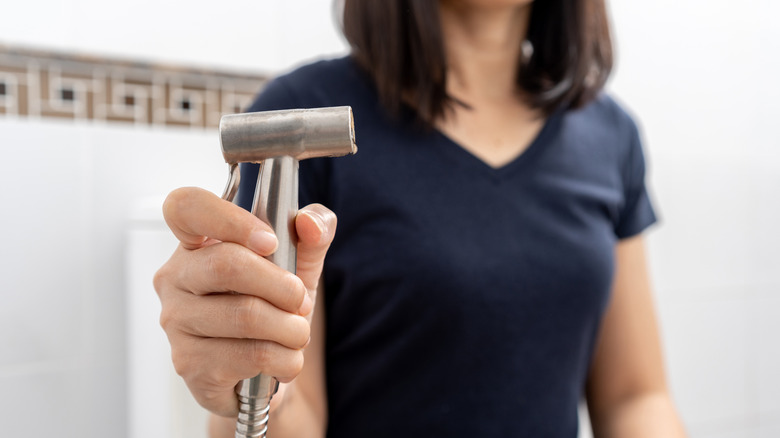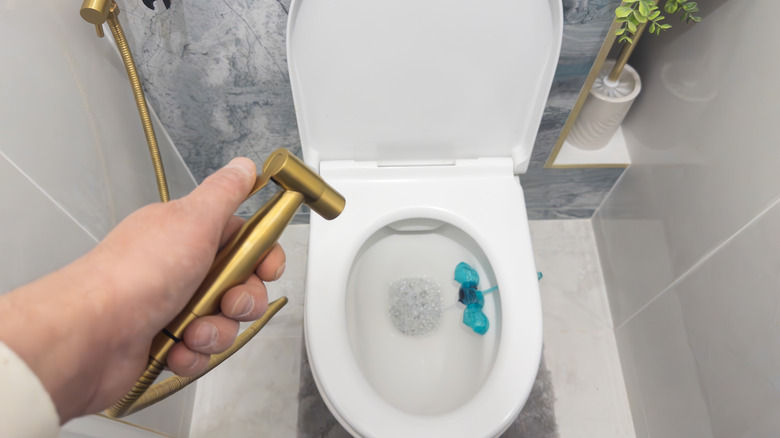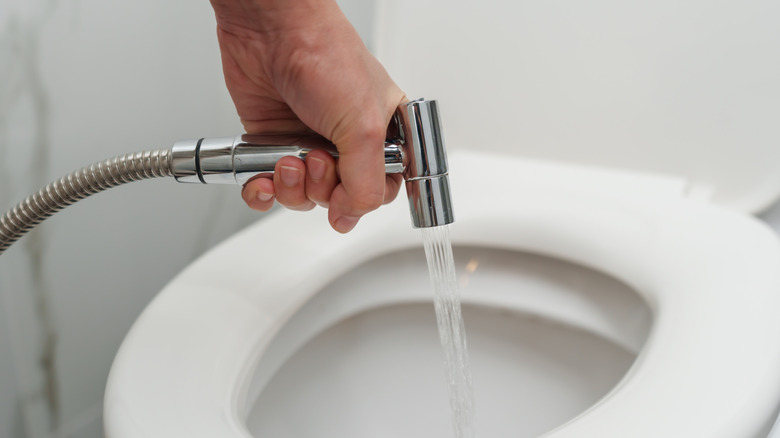Is A Handheld Bidet Right For Your Bathroom? Here's Everything You Need To Know
There are few things more frustrating than discovering you're out of toilet paper. This is why you may want to make the switch and install a bidet in your bathroom. Having one not only leaves you feeling fresher, but it also helps you spend less on toilet paper and is more environmentally-friendly (especially if you think about the one million trees that are annually cut for toilet paper).
But you might not automatically need those fancy seat attachments with built-in nozzles and warm water options. A handheld bidet is an option that is just as effective and even more affordable. This hose-like sprayer attaches to your toilet's water supply and lets you control the pressure and direction of the water manually.
Some hesitate to install handheld bidets because they are unsure if it's the right choice for them. That is understandable, though, as adding things to your home requires much thought. In the case of a handheld bidet, you'll want to weigh the convenience of installation and flexibility against the potential for water splashes due to the need to manually hold and aim the sprayer. Weighing the pros and cons can help you decide whether a handheld bidet is a lesser-known appliance that you never realized you're missing out on.
The benefits of a handheld bidet
Many are attracted to the easy installation of a handheld bidet. It only needs to be hooked up to the toilet's water system, without needing a professional plumber. Compare it to the fancier bidet seats, which require an electrical connection for heated water or its other advanced features. Another major plus is that handheld bidets aren't tied to the toilet seat. This means you don't need to replace your existing one, unlike a bidet seat that has specific requirements. So, if you're a renter or just someone who doesn't want to modify your toilet setup, a handheld bidet might be the best option.
Being able to control the nozzle of a handheld bidet means you can adjust the angle and water pressure to your exact preference. This feature actually helps it be more precise than a fixed bidet seat. Having this much control can be especially helpful for people with mobility issues who find it easier to direct the water themselves. It's also not solely for cleaning your body. You can use a handheld bidet to rinse out the toilet, or even fill up a mop bucket without awkwardly squeezing it into the sink.
How using a handheld bidet can be messy
Choosing a handheld bidet is not without its challenges. Perhaps the biggest one is that it takes some getting used to. A handheld bidet requires aim and control, unlike a bidet seat that does most of the work for you. Not being careful means you might end up with water splashing where you don't want it. Most people, however, get the hang of it after a few uses. It also usually just takes holding the sprayer close to the body and starting with low pressure to prevent unwanted messes.
You might also get surprised with the water temperature when you use a handheld bidet since it is directly connected to the toilet's water supply. This means that it has no built-in heating element that is usually seen in some bidet seats. This can deliver a bit of a shock if you live in a colder climate. A workaround here, however, is to install a mixing valve that connects to both hot and cold water lines, but this requires extra plumbing work.
There is also the risk of leaks since the sprayer is always connected to the water supply. A faulty valve or improper installation can lead to constant dripping, or worse, a burst hose. To avoid this, just make sure to choose a high-quality bidet with a strong shutoff valve. It's also good practice to turn off the valve when not in use.


